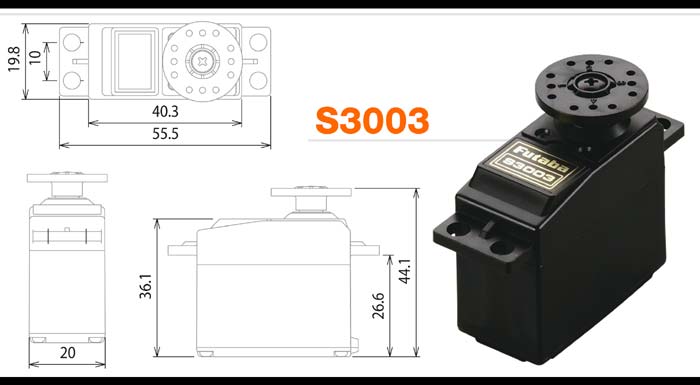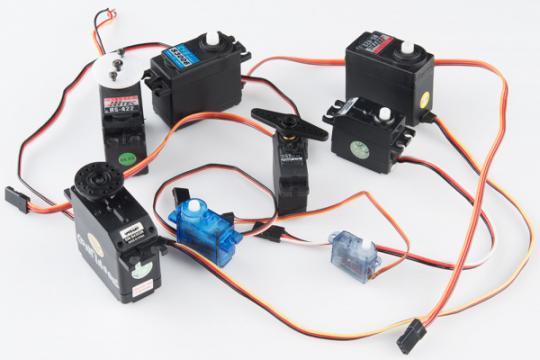You're still not exactly sure why your Particle Photons are sometimes dying violently when you connect them to servos. Often the death is accompanied by a plume of electric smoke, a little whiff of scary.
So you go on the Particle community boards to try to figure it out.
Slowly a theory emerges: there are power issues (volts 'n' amps) that you are blissfully unaware of, and have been probably just avoiding, without being aware of it.
But now you have to address them. $19 (the cost of a Photon) is too high a price to pay for your mistakes.
This discussion in particular -- Killed my Photon... How? -- focuses your attention. It made you feel like you had been living on borrowed time.
Turns out that servos operate at the limits of the Photon, in terms of volts, and amps. A little too much torque, a small, dirty spike in electricity, and it's curtains for the Photon.
So you decide to get serious about servos.
Servo Resources
Fortunately, you discover ServoCity.
And HobbyKing, which also has a good Servo section.
Adafruit put servos in context, in their Motor Selection Guide.
Sparkfun also has an excellent Servo Tutorial.
For example it has this: a table that summarizes common color schemes. A useful mnemonic is that the most drab color (black or brown) is usually ground, and red is usually the power supply.
| Pin Number | Signal Name | Color Scheme 1 (Futaba) |
Color Scheme 2 (JR) |
Color Scheme 3 (Hitec) |
| 1 | Ground | Black | Brown | Black |
| 2 | Power Supply | Red | Red | Red or Brown |
| 3 | Control Signal | White | Orange | Yellow or White |
Why Servos are Worth It
Because: 180 degrees of motion.
And stops anywhere along the way. And you can put on the brakes at any point, and wait for a few seconds. And then start back up again, in a different direction if you want to.
A continuous servo, an almost trivial variation, can spin 360 degrees, in both directions, and stop suddenly, and wait, and start spinning again.
Think of the possibilities for using servos to power these hand-cranked automata:
Or Light Play:

Light Play, at the Exploratorium in San Francisco
Or some variation on Paper Signals, which, significantly, relies on servos to make the vision work.

Paper Signals
With confidence surging, you order two servos:
The Futaba S3003 Standard Servo
https://www.futabarc.com/servos/specs-lineart/specs-futm0031.html

and the Hitec HS-422 Deluxe Standard Servo (which sounds like a contradiction of terms).

Both are about $10.
When they arrive, you eagerly consult the datasheets for both servos. And you are disappointed to learn that the power-consuming information is sketchy.
- For the Futaba:
Technical Specifications: |
|
|
– 4.8V – 6.0V |
|
– 0.23sec/60° |
|
– 0.19sec/60° |
|
– 3.2kg.cm |
|
– 4.1kg.cm |
|
– 3 - 5V |
|
– -20 to +60°C |
|
– Yes |
|
– 3 Pole Ferrite |
|
– Straight Cut Spear |
|
– 150mm |
|
– 41 x 20 x 36mm |
|
– 37.2g |
For the Hitec
HS-422 Servo Specifications
| Performance Specifications | |
| Operating Voltage Range (Volts DC) | 4.8V ~ 6.0V |
| Speed (Second @ 60°) | 0.21 ~ 0.16 |
| Maximum Torque Range oz. / in. | 46 ~ 57 |
| Maximum Torque Range kg. / cm. | 3.3 ~ 4.1 |
| Current Draw at Idle | 8 mA |
| No Load Operating Current Draw | 150 mA |
| Stall Current Draw | 800 mA |
| Dead Band Width | 8 µs |
You do find some additional power advice on the Particle community boards, re: servos.
Consider adding extra capacitors to the power supply +V and GND such as 0.1uF and say 47uF electrolytic near each servo and the Photon.
Servos can generate a good deal of electrical noise back on to their power supply and so extra filtering can't hurt. You might not need all servos to have the extra caps or you might try having them just at the Photon. Experiment and see.
The motors in the servos generate electrical noise on their power supply connection when they run, plus they can draw a lot of current when the motor goes from a stop to a start and that can cause low-voltage conditions for the other things being powered by the same supply. The capacitors filter the noise and help supply extra temporary current when the motor starts up. The low-value 0.1uF helps with high frequency noise and the larger valued (say) 47uF helps with temporary current and low frequency noise.
This is beneficial since the Photon will work better with a "clean" power supply that does not have noise or low-voltage conditions. You might only need one pair or you might need many depending on your wiring and current needs with multiple servos running at the same time or starting and stopping often. Start with one pair and add as needed--they are cheap parts.
